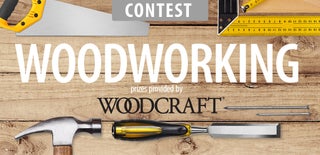Introduction: Customized Chopstick Maker
I’ll occasionally buy tools from Bridge City Tool Works, a US-based company that custom-designs and builds a wide variety of very unique and exquisitely crafted items. I say ‘occasionally’ because more often than not, they’re prohibitively expensive but I do respect their work; their planes are nothing short of art.
One system they released last year is the Chopstick Master, a device which allows you to take a square blank and perfectly plane the gentle tapers of a chopstick. It’s an interesting concept but I was not impressed with the final product; it’s gotten rave reviews otherwise so maybe it’s just me. In any event, I figured I’d attempt to build my own.
There aren’t too many tools needed for this project. A table saw and/or router table is needed to make the base and sled as well as a hand plane to integrate into the final product. A measuring device which is calibrated in Metric is a good idea as well; In my case, I used a digital caliper to measure the depths of the channels.
I also had a small supply of 1/4" brass rod on hand which came in handy for a few of the components.
Step 1: The Concept
We have a short series of operations which need to be applied to a blank to get the look we’re seeking. We want a chopstick that tapers from a square on one end to a perfect octagon at the tip, with a 4-sided pyramid on the back end. To do this, we must do the following:
1. We need to refine the size and length to be a perfect 7x7x270mm block.
2. The primary taper must be made on the first two sides, i.e. plane 1mm away from 2 adjacent sides so the blank becomes 7x7mm on one end and 6x6mm on the other
3. The taper must be made on the second pair of sides, reducing the blank to 5mm at the tip
4. The edge tapers must be cut to create an octagon at the tip.
5. The pyramid finial needs to be added to the top. This is a 30 degree, four sided point. To do this, we’ll construct a block with the required negative tapers so that the blanks can be inserted and planed to the final dimensions.
The plan is to use a stable, thick block of wood with a separate channel precisely milled to support each operation. We’ll also need a sled to hold a small plane which will do the cutting while not destroying the block or the blanks.
Step 2: The Block Part 1: the Concept and the Square Side
We’ll take care of the hard work up front. Starting from a 2x2x14” block of stable material (I used some tight-grained white oak), use the table saw to cut 1/4x1/4” cubes out of each corner of the block. These will serve as the rails upon which the sled will ride.
For the first operation, we want to plane an oversized square blank down to 7x7mm. Since my table saw doesn't do metric, I'm planning to start with a rough blank around 9/32" or 5/16" and plane it down to the correct size. I will be using a metric ruler to measure the depth of the channels that I cut.
Since we need a little separation between the plane and the block, use the table saw in a couple passes to cut a channel wide enough to fit a 5/16" blank that is about 6mm deep. This will give us the clearance needed to not ruin the plane. Once this is cut, add a stop near the far end; I used some scrap 1/4" brass rod which will hold fairly well and not shift over time.
Measure back from the stop 270mm and use a fine hand saw to cut a 90 degree slot across the center of the block. This will allow us to finalize the length of our blanks later on.
Easy enough, right?
Step 3: The Block Part 2: Cutting the Tapers
For the next two sides, we need to make two separate tapers, one that goes from 7mm to 6mm and the other that goes down to 5mm. To do this, use either a straight bit in a router table or the table saw to cut the channel as we did before; although I used a router for my version, I think I'd go with a table saw if I did it again, as there would be less chance of the blank slipping off the guard around the bit.
The only difference this time is that we'll glue a stop onto the face of the blank, and size it to exactly 1mm or 2mm in height, respectively. From here, run the blank over the router/saw and check the pitch with a measuring instrument. In my case, I used the pin gauge on my digital caliper to see when I got approximately 1mm difference in depth along the 270mm span. If it's too steep, remove more material from the stop. If there's not enough, add a few layers of tape and try again. Don't worry if the positioning is perfect, as you can add your depth stop anywhere along the length as needed to match the sled.
With the 1mm protrusion, you should have a 6mm to 5mm slope on one and a 6mm to 4mm slope on the other, still accounting for the plane's clearance. Finish up by adding your stop of choice.
Step 4: The Block Part 3: the Diagonal Taper and the Finial
The fourth side is more tricky, as we need to hold the stick at a 45 degree angle and plane the edges. As before, glue a stop on the far end and run it over your table saw in both directions with the blade set at 45 degrees. Getting the stop block sized correctly for this operation was a little tricky, but I estimated the pitch I'd need for the stick, and then ran the channel the entire length of the block. This will allow me to move the stick back and forth if more or less material needs to be removed, before settling on the location of the stop. If the pitch is off or you need to make fine adjustments, a shoulder plane can be used to lightly trim each face; just be sure to keep the pitches even. If you go too far, don't fret quite yet! It's fairly easy to move the stop along the block as needed.
Lastly, we need a way to plane a perfect pyramid finial. Use a miter saw to clip the end of the block away at 30 degrees, and use the table saw to cut a channel in the middle that is sized for the final blank. Use a screw to reattach the parts together so that they can securely hold the blank in place. Additionally, I added a few 3/16" rods to enable alignment. If I have more time to think through this, I'd probably add a cam lock to make this operation quicker.
For the finial block, you can add a dowel or a piece of rod to the side of the blank to correctly size the length. Drill the blank at 30 degrees, glue the dowel in place and check where the blank needs to end. Drill and attach a piece of scrap at the far end so that you can move the blank without losing track of the length.
For mine, I also added a relief cut and screw in order to clamp the block securely in place. In order to hold the block in place while in use, I attached a small brass tab to the front, which can rotate along with the block, and be securely held in place with my bench vice. I had initially experimented with holding the unit down with bench dogs, but they tended to slip a bit more than I wanted. The tab was drilled and lacquered before being attached with a 2" screw that allowed it to hold securely while still being able to spin without issue.
Once complete, I can clamp the assembly in the bench vice and drop a tapered blank into the slot and let it hit the stop on the lower side. Since they're planed to a close tolerance, it will fit snug but wont lock a blank in place. Take a few passes to trim each side down, rotating 90 degrees between each one, and making sure that the stop is not moving and that the finial looks square and even.
Step 5: The Sled
All of this is for nothing if you can't hold a plane above the block where it needs to go. Using some of the same heavy, white oak, cut a wider block for the sled and use the table saw to mill away a wide channel on the bottom to fit the block. This should extend about halfway through the sled and include the tabs on the sides.
Next, place your sacrificial plane (I used a restored #3 to keep a little weight) on the top at a shallow angle and trace around the bed. With a handheld router, carve through the blank until you come just shy of the lower channel. To keep the dust down, you can always run the perimeter and hack the middle out with a chisel. Clean it up with the straight bit again and check that the plane fits flat and even against the bottom without rocking.
Once everything fits, use any method to secure the plane in place. A quick-release jig clamp could work but I used some 1/4" rare earth magnets that I had available. Bore some 1/4" holes in the base, add some thin CA glue and press them to fit below the threshold. Once dry, the plane should snap in place and hold without moving unless you pry it off.
As a finish, I soaked the entire assembly in danish oil to add a little strength and durability to all of the parts. Any sort of varnish would be short-lived due to the surfaces sliding next to each other. If needed for smooth operation, the mating surfaces can be polished with wax as well.
Step 6: Testing!
If all goes well, this should work, right?
Cross your fingers and we'll find out!
Clamp the block to your bench and plane your blank down to a 7mm square. Take a small amount from each side so as to remove any remaining saw blade marks. Use a hand saw to cut the blank to the correct length.
Rotate the block 90 degrees and plane the first two adjacent surfaces to give you a 6mm square at the end.
Rotate the block again and plane the remaining sides.
Rotate the block once more and plane the diagonal tapers on each side. Check your progress and you should end up with something resembling an octagon at the end.
Attach the finial block to the end of the jig, tighten it down and adjust the stop to fit your blank. Plane down each of the four corners until you're left with a pyramid.
Lightly sand the chopstick with 400-600 grit sandpaper to take down any remaining rough edges and apply your choice of food-safe finishes. The original used fine mineral oil while I went with butcher block oil (essentially the same thing). Let the sticks dry and put them to use!
*Update #1: added a video demonstration of the final product.

Participated in the
Woodworking Contest 2017

Participated in the
Build a Tool Contest 2017











